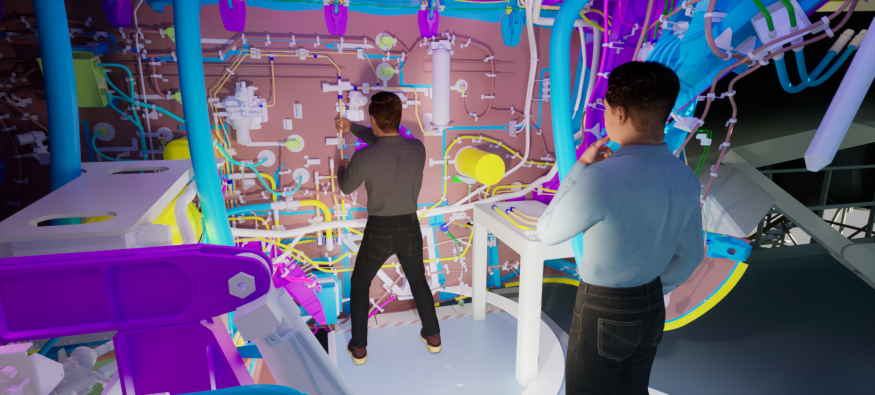Virtual reality technologies offer new perspectives for training. Immersive technologies can reproduce an ultra realistic environment and generate random events. They are used to train employees without test limits and without some reality constraints, geographic for example. Immersing learners in a 3D simulation is a way to better anticipate, progress and become more efficient when doing their tasks.
Simulate a larger-than-life environment
Virtual reality (VR) can generate immersive and interactive simulations of real environments. It can reproduce any type of situation in a very realistic way, with the possibility to add random happenings. This is how immersive technologies are a astounding tool for professional training. And so in many sectors for now, VR training benefits are confirmed and multiples.
In industry, the concept of digital twin is becoming more and more common. It creates a virtual version of a physical object, process or system. Used for maintenance and production, digital twins are also an asset for VR training. The data used to create these digital copies enables to generate environments for practice without any additional costs and logistics.
Today, virtual reality uses many related technologies. To gain even more interactivity and realism, some users wear haptic gloves during immersive experiences. These gloves reproduce the feeling of touch in virtual worlds thanks to a pressure system, the learner can then grab objects in VR. Therefore, virtualizing professional training is becoming easier and more concrete for employees.
Conduct training beyond the limits of the real world : the VR training benefits
Unlike classic practice, virtual reality favors long-distance employee training. The first benefit of vr training is the possibility to recreate inaccessible or difficult to access areas, in a detailed and true-to-life virtual world. By limiting business travel time, VR training is a time and money saving for companies.
In the industrial field, it is frequent to encounter maintenance problems related to the complexity of its operation, for example on an oil platform located in the middle of the Atlantic. Yet, the human expertise needed to solve this problem may not be on site. With virtual reality, engineers can fix the problem remotely, by training or guiding an employee on site.
Repeat endlessly without risk
Besides, one of the benefits of immersive learning is the lack of danger. For employees, working in a virtual simulation is a way to avoid exposure to risks related to an activity. Learning in virtual reality becomes ideal in business sectors like nuclear, defense or aeronautics. In many cases, a VR training programs can be used to prepare the teams before an onsite intervention. They can train as much time as they want, before going on site.
Practicing endlessly is a good confidence builder. Virtual Reality training enables to start over as many times as an employee thinks necessary, until he acquires the requested skills. Furthermore, the trainee can afford to make mistakes since he isn’t in a real situation. He can make errors and most importantly understand them by watching himself afterwards, and see where he can be better at. Over time, VR training benefits begin true and increase confidence which improves team efficiency, and therefore overall productivity.
Why training professionals in virtual reality can provide more knowledge in the long term
In terms of educational quality and learning continuity, virtual reality is the best tool for training. The consulting firm PwC published a study of the efficiency of VR compared to e-learning and traditional classroom learning. The results show that people learn 4 times faster with a virtual reality headset. Besides, 40% of the trainees noticed that they were more confident in applying the skills they had learned in VR.
We all know now the efficiency of immersive training in comparison to classic oral class. A classroom audience remembers about 20% of what it heard after about ten days.
On the other hand, a trainee immersed in a virtual environment where he can manipulate and practice, remembers 90% of the tasks he completed. This is the very principle of learning by doing. Virtual reality helps to acquire knowledge quickly and easily reuse it in the long term.
Teach punctually, specifically, effectively and other VR training benefits
In the end, the purpose of an immersive training programme applied to industry is to pass on minimal uses and practices needed for maintenance activities. Then, in contrast to standard professional training, virtual reality uses can be dedicated for one-off specific training sessions with relatively short implementation times.
SkyReal’s solution allows its clients to create technical training sessions in virtual reality. The company Safran is using it to train its teams and clients to install and repair its equipment. They conceived learning modules from existing 3D design data. This use case is a proof that VR training is fast and easy to deploy.
More recently, ArianeGroup also chose SkyReal’s solution to create immersive training exercises. There are many benefits for the company:
- Long distance collaboration between trainer and learner
- Unlimited repetition of procedures
- Test of knowledge of procedures for qualification
- Simulation of unexpected events
Finally, there are many benefits of training in virtual reality. In addition to saving time and money, learning in a virtual environment contributes to gaining confidence and therefore skills.
Companies have everything to earn by integrating immersive technologies into their professional training strategy, as their accessibility and deployment are becoming increasingly easier. In that way, VR training has a bright future.




